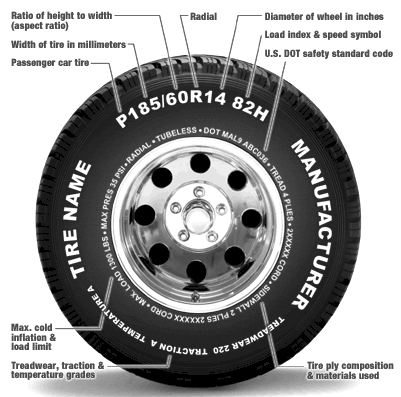Last Updated on April 21, 2024
Decoding the Numbers for Optimal Performance and Safety
You’ve likely come across a string of numbers and letters on the sidewall of a tire and wondered, “What do all these numbers mean?” Welcome to the world of tire sizing! While it might seem complex at first glance, understanding the basics can save you time and money and ensure optimal vehicle performance.
What Is Tire Sizing?
At its core, tire sizing represents the dimensions of the tire. These alphanumeric codes describe the tire’s width, aspect ratio, construction, and diameter. Knowing how to decode these numbers is crucial when shopping for a new set of tires or when contemplating a size upgrade.
How to Read Tire Sizes
Typically, a tire size might look like P215/65R15. Let’s break this down:
- P: Type of tire (P indicates it’s for passenger vehicles)
- 215: Width of the tire in millimeters
- 65: Aspect ratio (height of the sidewall as a percentage of the width)
- R: Radial construction
- 15: Diameter of the wheel in inches
Importance of Correct Tire Sizing
- Safety: Correctly sized tires ensure better traction and handling, essential for safety.
- Fuel Efficiency: Improper sizes can negatively affect your vehicle’s fuel efficiency.
- Vehicle Performance: The right tire size is paramount for the smoothest ride and optimal handling.
- Tire Longevity: Incorrectly sized tires wear out faster.
Deciphering the Code: Understanding the Complex World of Tire Sizing
Most consumers know very little about how tire sizing works and often overlook the important details that affect a tire’s handling, wear, and life. When you look at the sidewall of your tire, there is so much information it’s hard to find the size sometimes! So, let’s break down the details of tire sizing and make it easier to buy your next set.

Tire sizing can be broken down into:
- Service Type
- Section Width
- Sidewall Aspect Ratio
- Internal Construction
- Speed Rating
- Diameter
- Service Description
Demystifying Tire Labels: A Deep Dive into Service Types and Their Meanings
In today’s post, we are looking at the service type. Most tire sizes start with a letter or letters, indicating the kind of use or vehicle the tire was designed for. Here are the various service types:
- P (Passenger): This designation is the most common of the service types and indicates the tire sizing is P-metric. This service type indicates passenger vehicle use, including cars, minivans, sport utility vehicles, and light-load pickup trucks.
- T (Temporary Spare): A “T” indicates the tire is a spare tire, only to be used until the vehicle’s standard tire is repaired or replaced. Other restrictions, including max speed capacity, often exist when driving on a T service-type tire.
- LT (Light Truck): This letter designation can be found at the beginning or end of the tire size for light trucks. In most cases, the LT will be at the beginning, which implies the tire is for use on a light truck capable of towing large trailers and carrying heavy loads. If the LT is at the end of the tire size, the tire is intended for Light Trucks using a broad base or flotation type tires or the earlier “numeric” sizing system for Light Trucks.
- ST (Service Trailer): This service type indicates tires for service trailers. ST service-type tires should never be installed on a vehicle. Trailer tires are made and operate differently than vehicles designed to carry and pull large loads. ST tires should only be installed on trailers.
Next, we will break down the Section Width and Sidewall Aspect Ratio. I know it sounds so scientific, but it’s not.
Switching Sizes: Pros and Cons
There might be instances where you contemplate upgrading or changing the size. While this can lead to aesthetic improvements and potentially better handling, it’s essential to consult professionals to ensure compatibility with your vehicle’s specifications.
Pros
- Enhanced appearance
- Improved road grip
- Better vehicle stance
Cons
- Potential speedometer inaccuracies
- Altered fuel efficiency
- Suspension and brake system concerns
Conclusion
Deciphering tire sizing doesn’t have to be a daunting task. With a basic understanding, you can confidently navigate the numbers and ensure the best fit for your vehicle. Remember, the right size isn’t just about appearance; it’s about safety, performance, and the tire’s longevity.
Understanding tire sizing is paramount to ensuring optimal vehicle performance, safety, and longevity of your tires. By equipping ourselves with the knowledge of tire labels, we can make informed decisions when it’s time to replace or upgrade. With the correct fitment, your journey on the road becomes smoother and more efficient.
Ready to Find the Perfect Tire Size for Your Ride?
Don’t leave your tire size to guesswork. Trust Tire Easy for the best selection tailored to your needs.
Dive into our extensive collection and find the perfect fit for your vehicle today.
Upgrade, drive safely, and let every journey be smooth with Tire Easy!
FAQs
What do the three numbers mean on tire size in terms of tire sizing?
The three numbers on a tire size represent the section width, the sidewall aspect ratio, and the diameter of the wheel the tire fits on. For instance, in size “225/65R17”, “225” is the width of the tire in millimeters, “65” is the sidewall height represented as a percentage of the width, and “17” indicates the tire is designed for a 17-inch diameter wheel.
How are tire sizes calculated based on tire sizing?
Tire sizes are determined by measuring various aspects of the tire. The first number is the tire’s width in millimeters, measured from sidewall to sidewall. The second is the aspect ratio, which is the height of the sidewall as a percentage of the width. The third number (if present) is the diameter of the wheel the tire is meant to fit, measured in inches.
In terms of tire sizing, what do tire size numbers mean?
The numbers on a tire size indicate specific dimensions and characteristics. The first number denotes the tire’s width in millimeters. The second number, the aspect ratio, indicates the height of the tire’s sidewall as a percentage of its width. Lastly, if there’s a third number, it specifies the diameter of the wheel the tire is designed for in inches.
What is the TYRE inch size in the context of tire sizing?
In tire sizing, the “inch size” refers to the diameter of the wheel that the tire is designed to fit. It’s usually the last number in the tire size. For example, in “225/65R17”, the tire is made to fit a 17-inch diameter wheel. This measurement ensures the tire fits snugly onto the wheel, providing optimal performance and safety.










